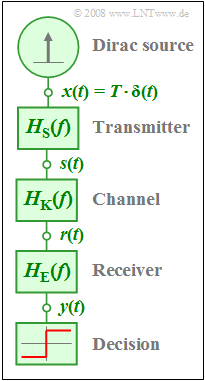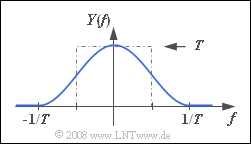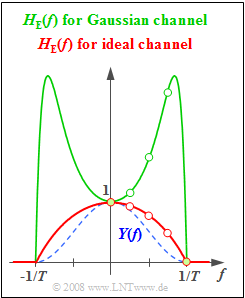Difference between revisions of "Aufgaben:Exercise 2.5Z: Nyquist Equalization"
| Line 55: | Line 55: | ||
| − | {First, let $H_{\rm K}(f) = 1$ hold ⇒ <u>ideal channel</u>. | + | {First, let $H_{\rm K}(f) = 1$ hold ⇒ <u>ideal channel</u>. Compute the frequency response $H_{\rm E}(f)$ for this case. <br>What values are obtained at the frequencies given below? |
|type="{}"} | |type="{}"} | ||
$|H_{\rm E}(f \cdot T = 0)| \ = \ $ { 1 3% } | $|H_{\rm E}(f \cdot T = 0)| \ = \ $ { 1 3% } | ||
| Line 64: | Line 64: | ||
| − | { | + | {Compute $H_{\rm E}(f)$ for the Gaussian-shaped channel $H_{\rm K}(f) = H_{\rm G}(f)$ according to the description. |
|type="{}"} | |type="{}"} | ||
$|H_{\rm E}(f \cdot T = 0)|\ = \ $ { 1 3% } | $|H_{\rm E}(f \cdot T = 0)|\ = \ $ { 1 3% } | ||
| Line 78: | Line 78: | ||
===Solution=== | ===Solution=== | ||
{{ML-Kopf}} | {{ML-Kopf}} | ||
| − | [[File:P_ID922__LZI_Z_2_5_a.png|right|frame| | + | [[File:P_ID922__LZI_Z_2_5_a.png|right|frame|Cosine-square spectrum]] |
'''(1)''' Mit dem konstanten Spektrum $X(f) = T$ erhält man für die Spektralfunktion des Empfängerausgangssignals $y(t)$: | '''(1)''' Mit dem konstanten Spektrum $X(f) = T$ erhält man für die Spektralfunktion des Empfängerausgangssignals $y(t)$: | ||
:$$Y(f)= T \cdot {H(f)}.$$ | :$$Y(f)= T \cdot {H(f)}.$$ | ||
| Line 88: | Line 88: | ||
| − | [[File:EN_LZI_Z_2_5c.png|right|frame| | + | [[File:EN_LZI_Z_2_5c.png|right|frame|Frequency Response of the Nyquist equaliser]] |
'''(2)''' Aus der Bedingung $H_{\rm S}(f) \cdot H_{\rm E}(f) = H(f)$ folgt im betrachteten Bereich: | '''(2)''' Aus der Bedingung $H_{\rm S}(f) \cdot H_{\rm E}(f) = H(f)$ folgt im betrachteten Bereich: | ||
:$$H_{\rm E}(f)= \frac{H(f)}{H_{\rm S}(f)} = \frac{\cos^2(\pi f T/2)}{\sin(\pi f T)/(\pi f T)}.$$ | :$$H_{\rm E}(f)= \frac{H(f)}{H_{\rm S}(f)} = \frac{\cos^2(\pi f T/2)}{\sin(\pi f T)/(\pi f T)}.$$ | ||
Revision as of 02:09, 17 September 2021
A digital baseband transmission system is modelled by the depicted block diagram.
- The "transmitter", "channel" and "receiver" components are described in the frequency domain by $H_{\rm S}(f)$, $H_{\rm K}(f)$ and $H_{\rm E}(f)$ .
- The overall frequency response $H(f) = H_{\rm S}(f) \cdot H_{\rm K}(f) \cdot H_{\rm E}(f)$ has a $\cos^2$–shaped curve:
- $$H(f) = \left\{ \begin{array}{c} \cos^2\left({\pi}/{2} \cdot f \cdot T \right) \\ 0 \\ \end{array} \right.\quad \quad \begin{array}{*{10}c} {\rm{f\ddot{u}r}} \\ {\rm{f\ddot{u}r}} \\ \end{array}\begin{array}{*{20}c} {\left| \hspace{0.005cm} f\hspace{0.05cm} \right| < 1/T,} \\ {\left|\hspace{0.005cm} f \hspace{0.05cm} \right| \ge 1/T.} \\ \end{array}$$
- The signal $y(t)$ before the decision circuit thus exhibits equidistant zero crossings at intervals of $T$ .
- It is assumed here that the source emits a Dirac-delta $x(t)$ with weight $T$ (see graph).
It is pointed out that this is a so-called "Nyquist system".
As will be discussed in detail in the book Digital Signal Transmission, these Nyquist systems represent an important class of digital transmission systems since the sequentially transmitted symbols do not influence each other in such systems.
However, these far-reaching aspects are not needed for the solution of this task.
Here, it is only assumed that
- the transmission pulse $s(t)$ be rectangular with pulse duration $T$:
- $$H_{\rm S}(f) = {\rm si}(\pi f T),$$
- the channel is assumed to be ideal up to and including subtask (2) while for the last subtask (3) the following shall hold:
- $$H_{\rm K}(f) = H_{\rm G}(f) = {\rm e}^{-\pi(f \cdot T)^2} .$$
For both channels, the receiver– and simultaneously the equaliser frequency response $H_{\rm E}(f)$ are searched-for so that the overall frequency response has the desired Nyquist shape.
Please note:
- The task belongs to the chapter Linear Distortions.
- The following trigonometric relation is assumed to be known:
- $$\frac{\cos^2(\alpha /2)}{\sin(\alpha )} = {1}/{2} \cdot {\rm cot}(\alpha /2) .$$
Questions
Solution
(1) Mit dem konstanten Spektrum $X(f) = T$ erhält man für die Spektralfunktion des Empfängerausgangssignals $y(t)$:
- $$Y(f)= T \cdot {H(f)}.$$
- Der Signalwert bei $t = 0$ ist gleich der Fläche unter $Y(f)$.
- Wie aus der nebenstehenden Skizze hervorgeht, ist diese gleich $1$. Daraus folgt:
- $$y(t = 0)\; \underline{= 1}.$$
(2) Aus der Bedingung $H_{\rm S}(f) \cdot H_{\rm E}(f) = H(f)$ folgt im betrachteten Bereich:
- $$H_{\rm E}(f)= \frac{H(f)}{H_{\rm S}(f)} = \frac{\cos^2(\pi f T/2)}{\sin(\pi f T)/(\pi f T)}.$$
- Wegen $\cos(0) = 1$ und ${\rm si}(0) = 1$ gilt auch $H_{\rm E}(f = 0)\;\underline{=1}$.
- Mit der gegebenen trigonometrischen Umformung gilt weiter:
- $$H_{\rm E}(f) = {\pi f T}/{2} \cdot {\rm cot}\left( {\pi f T}/{2}\right),$$
- $$H_{\rm E}(f \cdot T = 0.25) = {\pi }/{8} \cdot {\rm cot}\left( 22.5^{\circ}\right) = {\pi }/{8} \cdot 2.414 = \hspace{0.15cm}\underline{0.948},$$
- $$H_{\rm E}(f \cdot T = 0.50) = {\pi }/{4} \cdot {\rm cot}\left( 45^{\circ}\right) = {\pi }/{4} \cdot 1 \hspace{0.15cm}\underline{= 0.785},$$
- $$ H_{\rm E}(f \cdot T = 0.75) = {3 \pi }/{8} \cdot {\rm cot}\left( 67.5^{\circ}\right) = {3 \pi }/{8} \cdot 0.414 \hspace{0.15cm}\underline{= 0.488},$$
- $$ H_{\rm E}(f \cdot T = 1.00)= { \pi }/{2} \cdot {\rm cot}\left( 90^{\circ}\right) ={ \pi }/{2} \cdot 0 \hspace{0.15cm}\underline{ = 0}.$$
(3) Unter Berücksichtigung des Gaußkanals gilt:
$$H_{\rm E}(f)= \frac{H(f)}{H_{\rm S}(f) \cdot H_{\rm K}(f)} = H_{\rm
E}^{(2)}(f)\cdot {\rm e}^{\pi (f\hspace{0.05cm}\cdot \hspace{0.05cm} T)^2}.$$
Hierbei bezeichnet $H_{\rm E}^{(2)}(f)$ den bei der Teilaufgabe (2) berechneten Entzerrerfrequenzgang unter der Voraussetzung eines idealen Kanals. Man erhält folgende numerische Ergebnisse:
- $$H_{\rm E}(f\cdot T = 0) = 1 \cdot {\rm e}^{0} \hspace{0.15cm}\underline{= 1},$$
- $$H_{\rm E}(f \cdot T = 0.25) = 0.948 \cdot 1.217 \hspace{0.15cm}\underline{= 1.154},$$
- $$H_{\rm E}(f \cdot T = 0.50) = 0.785 \cdot 2.193 \hspace{0.15cm}\underline{= 1.722},$$
- $$H_{\rm E}(f \cdot T = 0.75) = 0.488 \cdot 5.854 \hspace{0.15cm}\underline{= 2.857},$$
- $$H_{\rm E}(f \cdot T = 1.00) = 0 \cdot 23.141 \hspace{0.15cm}\underline{= 0}.$$
Die grüne Kurve in obiger Grafik fasst die Ergebnisse dieser Teilaufgabe zusammen.


